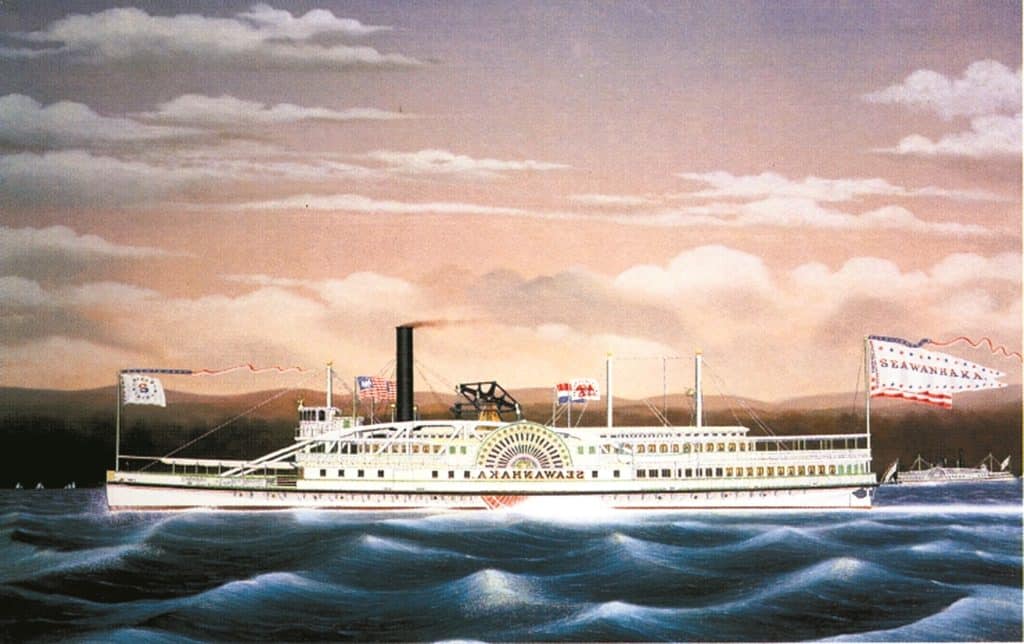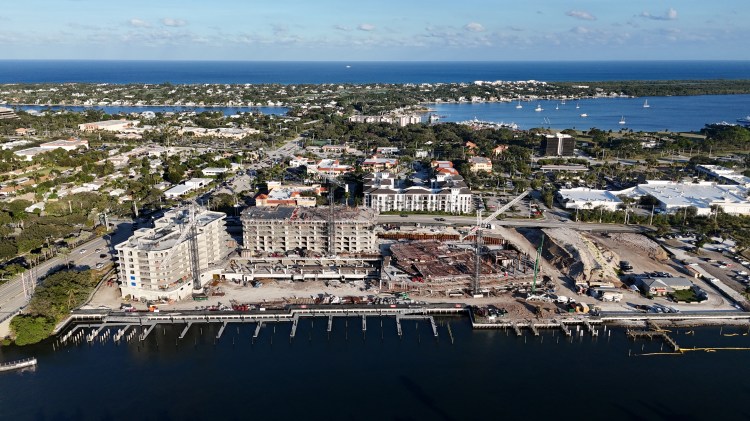Before the railroad began to wind its way through the quaint villages of the North Shore, the major source of transportation was the sidewheel steamboat in the early 1800s. Steamboat service ignited the luxurious and bustling Gold Coast-era of Long Island. Water travel was the only way to get from Manhattan to Long Island. The Brooklyn Bridge would not be built until 1883.

In 1827, Dr. Thomas Garvie negotiated with Cornelius Vanderbilt to begin a regular ferry service between his proposed dock facilities at Garvies Point in Glen Cove and Manhattan. The first steamboats evolved from the engineering of Robert Fulton’s 1807 design for the first practical steamboat, the Clermont.
The Linnaeus, captained by Elijah Peck, was one of the first recorded steamboats to provide service to the North Shore in 1829. The Linnaeus was a small steamboat in comparison to the size of the ships that would eventually operate on the line. She left Glen Cove every morning at 6:30 a.m., stopping at New Rochelle at 7:30 a.m., Whitestone at 8:30 a.m., before finally arriving at the Fulton Market slip. She return-voyaged every afternoon at 3 p.m. Fare one-way was a mere three shillings (one shilling would equal a small fraction of today’s penny).
For the first time, there was reliable and convenient travel from Manhattan to Long Island. Before the arrival of steamboat service, travel by water had been by sloop, a one-masted sailboat, which was much slower than steam, dependent on wind, tide, weather and was far less dependable.
The impact of steamboat service to the North Shore was immediately noticeable. Social gatherings ramped up, agricultural trade and mail service increased. With increased steamboat service from Manhattan, North Shore communities began to see civic, cultural and social organizations (debating societies, literary circles, musical and agricultural societies) begin to establish, mimicking similar organizations in New York City.
To handle summer vacationers, Glen Cove, Sea Cliff and other resort villages along the coast erected their first hotels, resorts, taverns, clam bars and oyster houses. The arrival of steamboat service encouraged wealthy Manhattan businessmen to purchase North Shore estates as their summer homes, while still being able to commute back to the city to manage their business affairs. The Pratts, Morgans, Woolworths and Guggenheims, all took homes near steamboat landings.
In 1873, when the Sea Cliff Hotel was nearly complete, a new line of steamboats, including the T. V. Arrowsmith, made two trips a day to Manhattan. Fare was 35 cents and commuter books were available for frequent travelers.

More than 40 steamboats worked the line from Manhattan to the North Shore over the course of time, making stops in Whitestone, Great Neck, Sands Point, Roslyn, Sea Cliff, Glenwood Landing and Glen Cove. Some of the notable steamboats which had graced the shores of the island, and their years of service, included:
• Linnaeus, 1829
• Croton, 1852
• George Law, 1852-1895
• Glen Cove, 1854-1861 (served as Confederate Troops transport, was burned and sunk in the James River during the Civil War)
• Long Island (burned during the Civil War)
• General Sedgwick, 1862-1902
• Jesse Hoyt, 1862-1889
• T.V. Arrowsmith, 1861-1910
• City of Hudson, 1864-1889
• Flushing
• Statesman
• Fairfield
• Nimrod
• Westchester
• Sun
• American Eagle
• Norwalk
• Mayflower
• Island City
• Stamford
• Nantasket
• Wyandotte
• Orient
• Sagamore, ended in 1916
• D.H. Martin
• Rye Cliff, 1911-1918 (reconstructed from the car ferry General Knox and primarily used for auto transport, burned at Sea Cliff south dock; the wreckage remains are approximately 200 yards off the west shore south of Dock Hill Park in Sea Cliff)
• Seawanhaka, 1866-1880 (burned tragically on a return trip to the North Shore)
• Idlewild, 1876-1901
During the Civil War period (April 12, 1861 – May 9, 1865), the government commandeered nearly all of the steamboats for troops, supplies, food and ammunition transport in the south.
The Idlewild reestablished service following the loss of the Seawanhaka. Some claim the Idlewild was the last steamboat to service the North Shore, possibly running until 1908, but a news article in the Glen Cove Echo, dated June 3, 1916, announces the final discontinuation of steamboat service to be made by the Sagamore.
The Long Island Railroad formed in 1834, but only arrived as far as Glen Cove in 1867, slowly replacing all of the coastal steamboat service. The railroad service did cost more, but was safer. Within a half of a century, rail had replaced the steamboat service.
Information courtesy of Great Neck Library Local History Room, Glen Cove Public Library Robert R. Coles Long Island History Room, the archives of Harper’s Weekly, the archives of The New York Times and the Brooklyn Daily Eagle, the archives of the Glen Cove Record Pilot and the Glen Cove Echo, The Splendid Steamer: Glen Cove by Edward Magnani, Long Island Chronicle (Winter 1989), the Maritime Oceanological Society of Nassau Community College.






























